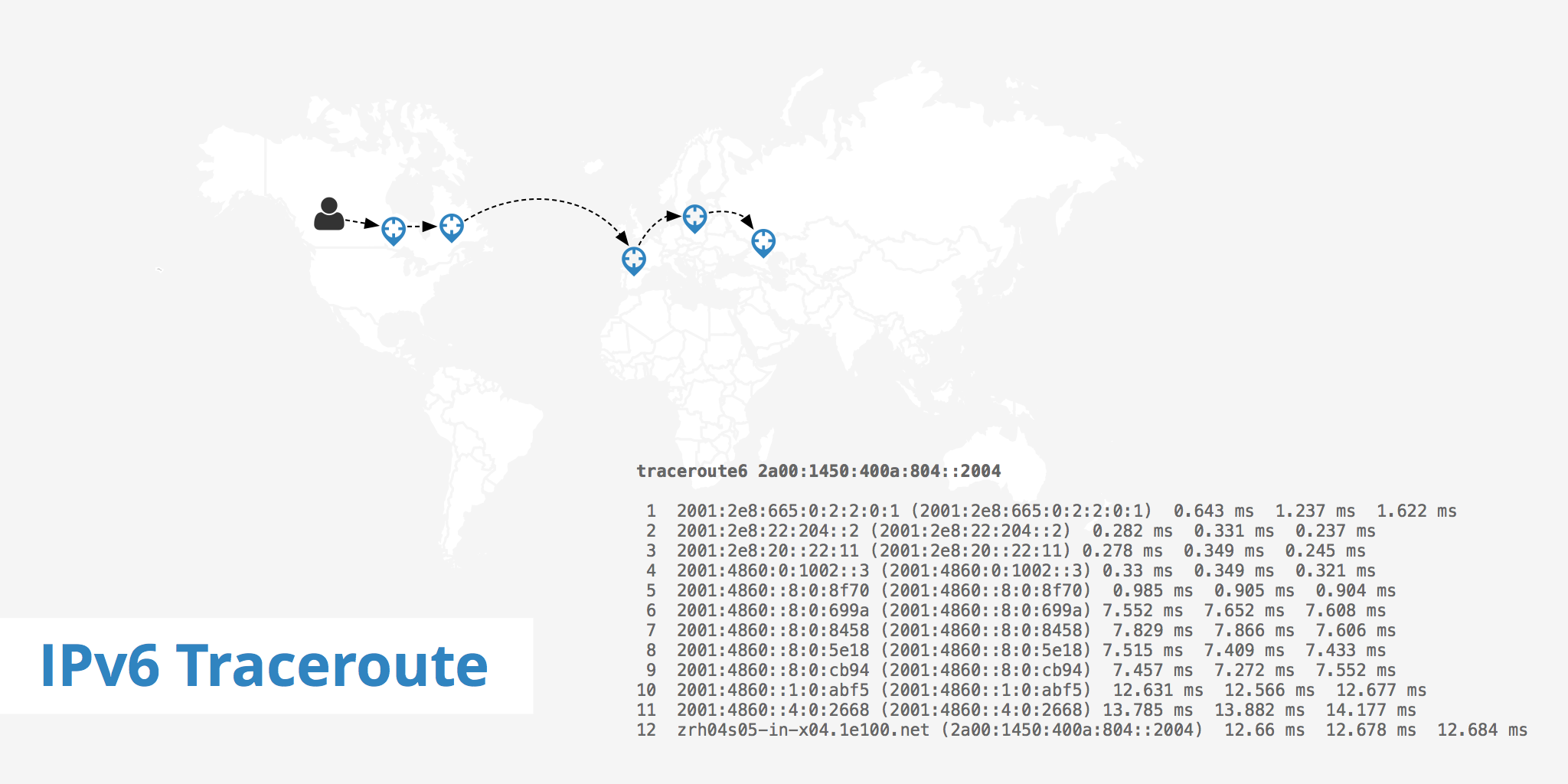IPv6 Traceroute

What is IPv6?
IPv6, or Internet protocol version 6, is the most recent update to the Internet Protocol and is the successor of IPv4. The main reason for updating the Internet Protocol from IPv4 to IPv6 is simply due to the shortage of available IP addresses. IPv4 is currently able to supply 4.2 billion IP addresses while IPv6 is able to provide 340 undecillion (36 zeros). Read our complete IPv6 tutorial to learn more about the differences and improvements of IPv6 compared to IPv4.
The transition from IPv4 to IPv6 is gradual and will certainly take time, however, is necessary in order to keep moving the web forward. As the Internet moves from using IPv4 to IPv6 there will also be many updates to online tools. For example, traceroute tools are being updated / created to support IPv6 traceroute. This will allow you to perform a traceroute command to a particular IPv6 supported host.
What is a traceroute command?
A traceroute command is used to test the connection and latency between two predetermined points. For example, if you want to test the connection between your current location and Google's public DNS for example, you would need to run the following command traceroute 8.8.8.8 (on Mac) or tracert 8.8.8.8 (on Windows).
These commands will return a list of hops, round trip times, and router IP addresses. For example:
traceroute 8.8.8.8
traceroute to 8.8.8.8 (8.8.8.8), 64 hops max, 52 byte packets
1 192.168.2.1 (192.168.2.1) 3.955 ms 3.292 ms 5.014 ms
2 loop0.18w.ba05.chtw.pe.aliant.net (142.166.182.59) 2.952 ms 5.770 ms 3.442 ms
3 be14-181.dr01.chtw.pe.aliant.net (142.176.23.33) 7.821 ms 5.838 ms 5.213 ms
4 be3.dr01.smsd.pe.aliant.net (142.166.149.110) 8.724 ms 7.236 ms 7.260 ms
5 be1.cr01.mctn.nb.aliant.net (142.166.185.86) 9.881 ms 9.749 ms 9.017 ms
6 be6.cr01.stjh.nb.aliant.net (142.166.185.129) 12.647 ms 9.468 ms 10.849 ms
7 be5.bx01.nycm.ny.aliant.net (207.231.227.114) 26.878 ms 24.492 ms 30.930 ms
8 72.14.209.206 (72.14.209.206) 46.522 ms 25.232 ms 24.857 ms
9 108.170.232.73 (108.170.232.73) 26.564 ms 29.031 ms
108.170.232.85 (108.170.232.85) 24.445 ms
10 108.170.234.1 (108.170.234.1) 25.053 ms
108.170.233.255 (108.170.233.255) 28.022 ms
108.170.235.83 (108.170.235.83) 30.632 ms
11 google-public-dns-a.google.com (8.8.8.8) 26.675 ms 25.241 ms 24.752 ms
The example above is using a traditional IPv4 address however, IPv6 addresses are formatted differently. IPv6 addresses are written in 8 hexadecimal blocks separated by colons. Any leading zeros can be omitted from the address, therefore if we have the following IPv6 address: 3407:3530:0242:0069:0c3f:54g5:0951:b041 it can be rewritten as: 3407:3530:242:69:c3f:54g5:951:b041.
There are many IPv6 traceroute tools available to accommodate the new IP format. The following section will describe a few of these tools.
IPv6 traceroute tools
With online IPv6 traceroute tools, you can specify an IPv6 address or hostname and run a traceroute command against it. The result of the traceroute will look similar to the results of an IPv4 traceroute, only the IP address formatting will be different. We have compiled a comprehensive list of traceroute and BGP looking glass tools and categorized the traceroute tools by region so that you can easily find a location to test from.
Furthermore, to perform an IPv6 traceroute command directly from your CLI, you must first ensure that your machine supports IPv6. Once you have confirmed IPv6 support, you can run a traceroute command using the following:
- Mac or Linux:
traceroute6 2a00:1450:400a:804::2004 - Windows:
tracert -6 2a00:1450:400a:804::2004
Additionally, if you don't require all the details included in a traceroute, you can simply use an IPv6 Ping tool.